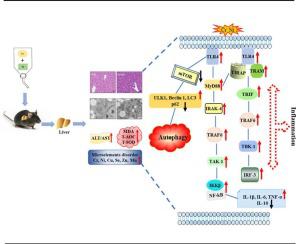当前位置:
X-MOL 学术
›
Sci. Total Environ.
›
论文详情
Our official English website, www.x-mol.net, welcomes your feedback! (Note: you will need to create a separate account there.)
Effects of chronic Cr and Ni co-exposure on liver inflammation and autophagy in mice by regulating the TLR4/mTOR pathway
Science of the Total Environment ( IF 9.8 ) Pub Date : 2024-03-22 , DOI: 10.1016/j.scitotenv.2024.171921 Xianhong Cao , Shuangyan Zheng , Yizhou Zeng , Yan Shi , Jun Du , Cheng Huang , Yufan Shen , Ping Liu , Xiaoquan Guo , Xiaona Gao
Science of the Total Environment ( IF 9.8 ) Pub Date : 2024-03-22 , DOI: 10.1016/j.scitotenv.2024.171921 Xianhong Cao , Shuangyan Zheng , Yizhou Zeng , Yan Shi , Jun Du , Cheng Huang , Yufan Shen , Ping Liu , Xiaoquan Guo , Xiaona Gao

|
Exposure to Cr and/or Ni can have widespread implications on the environment and health. However, the specific toxic effects of chronic Cr and Ni co-exposure on mice liver have not been reported. To ascertain the combined toxic effects of chronic Cr and Ni co-exposure on liver damage in mice, 80 6-week-old female C57BL/6 J mice were randomly divided into 4 groups: the Con group, Cr group (Cr 50 mg/L), Ni group (Ni 110 mg/L), and Cr + Ni group (Cr 50 mg/L + Ni 110 mg/L). The trial period lasted for 16 weeks. The results showed that Cr and/or Ni increased liver weight and liver index ( 0.05) in mice, caused histological abnormality and ultrastructural damage, and micronutrients imbalance in mice liver. These findings serve as the basis for subsequent experiments. Compared with the individual exposure group, chronic Cr and Ni co-exposure resulted in decreased levels and activities of ALT, AST, MDA, T-AOC, and T-SOD ( 0.05) in liver tissue, and decreased the mRNA expression levels of the TLR4/mTOR pathway related factors (TLR4, TRAM, TRIF, TBK-1, IRF-3, MyD88, IRAK-4, TRAF6, TAK-1, IKKβ, NF-κB, IL-1β, IL-6, TNFα, ULK1, Beclin 1, LC3) ( 0.05) and decreased the protein expression levels of the factors (TLR4, MyD88, TRAF6, NF-κB p50, IL-6, TNFα, ULK1, LC3II/LC3I) ( 0.05). Moreover, factorial analysis revealed the interaction between Cr and Ni, which was manifested as antagonistic effects on Cr concentration, Ni concentration, and TLR4, MyD88, NF-κB, mTOR, LC3, and p62 mRNA expression levels. In conclusion, the TLR4/mTOR pathway as a mechanism through which chronic Cr and Ni co-exposure induce liver inflammation and autophagy in mice, and there was an antagonistic effect between Cr and Ni. The above results provided a theoretical basis for understanding the underlying processes.
中文翻译:

慢性铬镍共暴露通过调节TLR4/mTOR通路对小鼠肝脏炎症和自噬的影响
接触 Cr 和/或 Ni 会对环境和健康产生广泛的影响。然而,慢性Cr和Ni共同暴露对小鼠肝脏的具体毒性作用尚未见报道。为明确慢性Cr、Ni共暴露对小鼠肝损伤的综合毒性作用,将80只6周龄雌性C57BL/6 J小鼠随机分为4组:Con组、Cr组(Cr 50 mg/ L)、Ni 组(Ni 110 mg/L)和 Cr + Ni 组(Cr 50 mg/L + Ni 110 mg/L)。试用期持续16周。结果表明,Cr和/或Ni增加小鼠肝脏重量和肝脏指数(0.05),引起小鼠肝脏组织学异常和超微结构损伤以及微量营养素失衡。这些发现为后续实验奠定了基础。与单独染毒组相比,慢性Cr、Ni联合染毒导致肝组织中ALT、AST、MDA、T-AOC、T-SOD水平和活性降低(0.05),且肝组织中mRNA表达水平降低。 TLR4/mTOR通路相关因子(TLR4、TRAM、TRIF、TBK-1、IRF-3、MyD88、IRAK-4、TRAF6、TAK-1、IKKβ、NF-κB、IL-1β、IL-6、TNFα、ULK1 、Beclin 1、LC3) (0.05) 并降低因子 (TLR4、MyD88、TRAF6、NF-κB p50、IL-6、TNFα、ULK1、LC3II/LC3I) (0.05) 的蛋白表达水平。此外,因子分析揭示了Cr和Ni之间的相互作用,表现为对Cr浓度、Ni浓度以及TLR4、MyD88、NF-κB、mTOR、LC3和p62 mRNA表达水平的拮抗作用。综上所述,TLR4/mTOR通路作为慢性Cr、Ni共暴露诱导小鼠肝脏炎症和自噬的机制,且Cr、Ni之间存在拮抗作用。上述结果为理解底层过程提供了理论基础。
更新日期:2024-03-22
中文翻译:

慢性铬镍共暴露通过调节TLR4/mTOR通路对小鼠肝脏炎症和自噬的影响
接触 Cr 和/或 Ni 会对环境和健康产生广泛的影响。然而,慢性Cr和Ni共同暴露对小鼠肝脏的具体毒性作用尚未见报道。为明确慢性Cr、Ni共暴露对小鼠肝损伤的综合毒性作用,将80只6周龄雌性C57BL/6 J小鼠随机分为4组:Con组、Cr组(Cr 50 mg/ L)、Ni 组(Ni 110 mg/L)和 Cr + Ni 组(Cr 50 mg/L + Ni 110 mg/L)。试用期持续16周。结果表明,Cr和/或Ni增加小鼠肝脏重量和肝脏指数(0.05),引起小鼠肝脏组织学异常和超微结构损伤以及微量营养素失衡。这些发现为后续实验奠定了基础。与单独染毒组相比,慢性Cr、Ni联合染毒导致肝组织中ALT、AST、MDA、T-AOC、T-SOD水平和活性降低(0.05),且肝组织中mRNA表达水平降低。 TLR4/mTOR通路相关因子(TLR4、TRAM、TRIF、TBK-1、IRF-3、MyD88、IRAK-4、TRAF6、TAK-1、IKKβ、NF-κB、IL-1β、IL-6、TNFα、ULK1 、Beclin 1、LC3) (0.05) 并降低因子 (TLR4、MyD88、TRAF6、NF-κB p50、IL-6、TNFα、ULK1、LC3II/LC3I) (0.05) 的蛋白表达水平。此外,因子分析揭示了Cr和Ni之间的相互作用,表现为对Cr浓度、Ni浓度以及TLR4、MyD88、NF-κB、mTOR、LC3和p62 mRNA表达水平的拮抗作用。综上所述,TLR4/mTOR通路作为慢性Cr、Ni共暴露诱导小鼠肝脏炎症和自噬的机制,且Cr、Ni之间存在拮抗作用。上述结果为理解底层过程提供了理论基础。



























 京公网安备 11010802027423号
京公网安备 11010802027423号